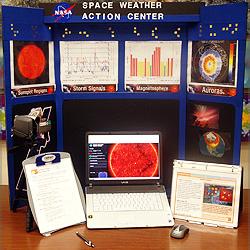Source Institutions
Source Institutions
Add to list Go to activity
Activity link broken? See if it's at the internet archive

In this interdisciplinary activity, learners create a Space Weather Action Center (SWAC) to monitor solar storms and develop real SWAC news reports. Learners work in teams to first investigate sunspot regions, storm signals, a magnetosphere, and auroras and share their research with their peers. Then, learners assemble an instructional flip chart, data collection clipboards/notebook, and display board for their SWAC. Learners conclude the activity by writing their own weather reports, which can be filmed or broadcast if equipment is available. Once learners create a SWAC, solar storm research and reporting can become an ongoing activity.
- Under 5 minutes
- 4 to 24 hours
- Over $20 per group of students
- Ages 8 - 14
- Activity, Exhibit, Lesson/Lesson Plan
- English
Quick Guide
Materials List (per group of students)
- Drawing supplies (paper, pencils, markers, etc.)
- Blackout Video Clips
- Understanding the Sun Questionnaire
- Answers from Understanding the Sun
- Printouts of imagery from the Space Weather Media Viewer (optional)
- One 3-ring binder
- Fifteen pocket protectors
- Sunspot Regions Flip Chart
- Storm Signals Flip Chart
- Magnetosphere Flip Chart
- Aurora Flip Chart
- Instructional Flip Chart
- Four clipboards
- Four composition books or notebooks
- Four pencils
- Sunspot Regions Data Collection Sheet
- Storm Signals Data Collection Sheet
- Magnetosphere Data Collection Sheet
- Auroras Data Collection Sheet
- Science Display Board (black is preferred)
- Styrofoam ball (3-6 in. diameter)
- Clip board with plastic sleeves
- Packet of Pipe Cleaners (red, blue, green, yellow, purple)
- Glue Stick or Spray Glue
- Heavy Duty or Industrial Strength Velcro
- Scissors
- Paint and brushes (blue, green, yellow, red, orange, black)
- Paper clips
- Magic markers (assorted colors)
- Yarn (assorted colors)
- Space Weather Action Center Script Template
- At least one (1) Internet capable desktop or laptop computer
Subjects
-
Earth and Space Science
-
Astronomy
- Stars and Galaxies
- Probes, Satellites and Spacecraft
-
Earth Processes
- Weather and Climate
- Earth Structure
- Earth, Moon and Sun
-
Solar System
- The Sun
-
Astronomy
-
Physical Sciences
-
Electricity and Magnetism
- Electric Charges and Currents
- Electromagnetic Fields
-
Energy
- Potential and Kinetic Energy
- Vibration and Waves
-
Light and Optics
- Sunlight and Color
- Motion and Forces
-
Structure and Properties of Matter
- Elementary Particles and Nuclear Physics
-
Electricity and Magnetism
-
Engineering and Technology
-
Computing
- Information Technology
-
Technology
- Information and Communication
-
Computing
-
Mathematics
-
Data Analysis and Probability
- Data Analysis
- Data Collection
- Data Representation
- Number and Operations
- Representation
-
Data Analysis and Probability
-
The Nature of Science
-
The Scientific Process
- Asking Questions
- Conducting Investigations
- Gathering Data
- Formulating Explanations
- Communicating Results
- Science as a Career
-
The Scientific Process
Informal Categories
- Computers
- Photography and Film/Video
Audience
To use this activity, learners need to:
- see
- see color
- use keyboard
- use mouse
- touch
Learning styles supported:
- Involves teamwork and communication skills
- Involves hands-on or lab activities
Other
Includes alignment to state and/or national standards:
This resource is part of:
Access Rights:
- Free access
By:
- Sun-Earth Connection Education Forum, NASA
Rights:
- Public domain, ,
